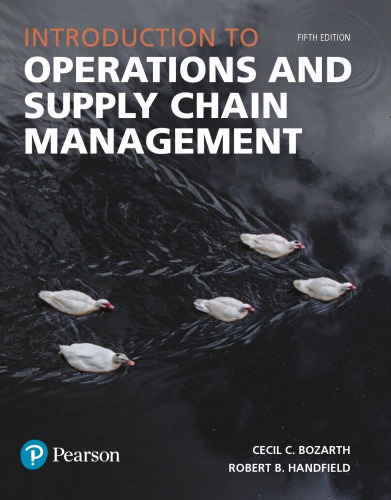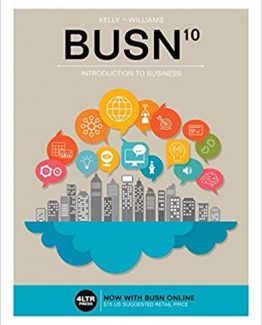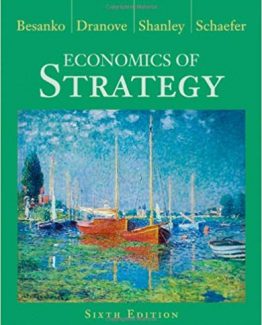Introduction to Operations and Supply Chain Management 5th Edition by Cecil Bozarth, ISBN-13: 978-0134740607
[PDF eBook eTextbook]
- Publisher: Pearson; 5th edition (January 18, 2018)
- Language: English
- 528 pages
- ISBN-10: 0134740602
- ISBN-13: 978-0134740607
For courses in operations and supply chain management.
An integrated approach to operations and supply chain management.
Introduction to Operations and Supply Chain Management is an integrated, comprehensive introduction to both operations and supply chain management (SCM). The text remains engaging and brief while integrating all of the major concepts of both subjects in one cohesive source. The 5th Edition contains updated content and thorough coverage of analytical tools and techniques that students will apply to their careers in operations and SCM. It explores these topics in an interesting and relatable manner, providing students with real-world examples and easy-to-understand material.
Table of Contents:
Preface
New to This Edition
Solving Teaching and Learning Challenges
Developing Employability Skills
Table of Contents Overview
Instructor Teaching Resources
Part I Creating Value through Operations and Supply Chains
Chapter One Introduction to Operations and Supply Chain Management
Chapter Outline
Chapter Objectives
Introduction
1.1 Why Study Operations and Supply Chain Management?
Operations Management
Supply Chain Management
1.2 Important Trends
Agility
Information Technologies
People
1.3 Operations and Supply Chain Management and You
Professional Organizations
Cross-Functional and Interorganizational Linkages
1.4 Employability Skills
Critical Thinking
Collaboration
Knowledge Application and Analysis
Information Technology Application and Computing Skills
1.5 Purpose and Organization of This Book
Chapter Summary
Key Terms
Discussion Questions
Problems
Problem for Section 1.1: Why Study Operations and Supply Chain Management?
Problems for Section 1.3: Operations and Supply Chain Management and You
Chapter Two Operations and Supply Chain Strategies
Chapter Outline
Chapter Objectives
Introduction
2.1 Elements of the Business
2.2 Strategy
2.3 Operations and Supply Chain Strategies
Customer Value
Four Performance Dimensions
Quality
Time
Flexibility
Cost
Trade-Offs among Performance Dimensions
Order Winners and Order Qualifiers
Stages of Alignment with the Business Strategy
Core Competencies in Operations and Supply Chains
Chapter Summary
Key Formula
Key Terms
Solved Problem
Problem
Calculating Value Indices at WarsingWare
Solution
Discussion Questions
Problems
Problems for Section 2.3: Operations and Supply Chain Strategies
Part II Establishing the Operations Environment
Chapter Three Process Choice and Layout Decisions in Manufacturing and Services
Chapter Outline
Chapter Objectives
Introduction
3.1 Manufacturing Processes
Production Lines and Continuous Flow Manufacturing
Job Shops
Batch Manufacturing
Fixed-Position Layout
Hybrid Manufacturing Processes
3D Printing
Linking Manufacturing Processes across the Supply Chain
Selecting a Manufacturing Process
The Product-Process Matrix
3.2 Product Customization Within the Supply Chain
Four Levels of Customization
The Customization Point
3.3 Service Processes
Service Packages
Service Customization
Customer Contact
Service Positioning
Services within the Supply Chain
3.4 Layout Decision Models
Line Balancing
Assigning Department Locations in Functional Layouts
Chapter Summary
Key Formulas
Key Terms
Solved Problem
Problem
Monster Bags
Solution
Discussion Questions
Problems
Problems for Section 3.4 Layout Decision Models
Chapter Four Business Processes
Chapter Outline
Chapter Objectives
Introduction
4.1 Business Processes
Improving Business Processes
4.2 Mapping Business Processes
Process Maps
Swim Lane Process Maps
4.3 Managing and Improving Business Processes
Measuring Business Process Performance
Productivity
Efficiency
Cycle Time
Benchmarking
The Six Sigma Methodology
Six Sigma People
Six Sigma Processes
Continuous Improvement Tools
4.4 Business Process Challenges and the Scor Model
How Standardized Should Processes Be?
Business Process Reengineering (BPR)
Coordinating Process Management Efforts across the Supply Chain
The SCOR Model
Chapter Summary
Key Formulas
Key Terms
Solved Problem
Problem
The repair process at Biosphere
Solution
Discussion Questions
Problems
Problems for Section 4.2: Mapping Business Processes
Problems for Section 4.3: Managing and Improving Business Processes
Chapter Five Managing Quality
Chapter Outline
Chapter Objectives
Introduction
5.1 Quality Defined
5.2 Total Cost of Quality
5.3 Total Quality Management
TQM and the Six Sigma Methodology
5.4 Statistical Quality Control
Process Capability
Six Sigma Quality
Control Charts
Sampling
Variable Types
X̄ and R Charts
p Charts
Acceptance Sampling
Taguchi’s Quality Loss Function
5.5 Managing Quality Across the Supply Chain
ISO 9000 Family
External Failures in the Supply Chain
Chapter Summary
Key Formulas
Key Terms
Using Excel in Quality Management
Solved Problem
Problem
Pulley Engineering
Solution
Discussion Questions
Problems
Problems for Section 5.4: Statistical Quality Control
Chapter Six Managing Capacity
Chapter Outline
Chapter Objectives
Introduction
6.1 Capacity
Measures of Capacity
Factors that Affect Capacity
Supply Chain Considerations
6.2 Three Common Capacity Strategies
6.3 Methods of Evaluating Capacity Alternatives
Cost
Demand Considerations
Expected Value
Decision Trees
Break-Even Analysis
Learning Curves
Other Considerations
6.4 Understanding and Analyzing Process Capacity
The Theory of Constraints
Waiting Line Theory
Arrivals
Service Times
Other Assumptions
Little’s Law
Chapter Summary
Key Formulas
Key Terms
Using Excel in Capacity Management
Solved Problem
Problem
Auvia Cruise Lines
Solution
Discussion Questions
Problems
Problems for Section 6.3: Methods of Evaluating Capacity Strategies
Problems from Section 6.4: Understanding and Analyzing Process Capacity
Supplement Chapter Six Advanced Waiting Line Theory and Simulation Modeling
Supplement Outline
Supplement Objectives
Introduction
6S.1 Alternative Waiting Lines
Assumptions behind Waiting Line Theory
Arrivals
Service Times
Other Assumptions
Waiting Line Formulas for Three Different Environments
6S.2 Simulation Modeling
Monte Carlo Simulation
Building and Evaluating Simulation Models with SimQuick
Supplement Summary
Discussion Questions
Problems
Problems for Section 6S.1: Alternative Waiting Lines
Problems for Section 6S.2: Simulation Modeling
References
Part III Establishing Supply Chain Linkages
Chapter Seven Supply Management
Chapter Outline
Chapter Objectives
Introduction
7.1 Why Supply Management is Critical
Global Sourcing
Financial Impact
Performance Impact
7.2 The Strategic Sourcing Process
Step 1: Assess Opportunities
Step 2: Profile Internally and Externally
Step 3: Develop the Sourcing Strategy
The Make-or-Buy Decision
Advantages and Disadvantages of Insourcing and Outsourcing
Total Cost Analysis
Portfolio Analysis
The “Routine” Quadrant
The “Leverage” Quadrant
The “Bottleneck” Quadrant
The “Critical” Quadrant
Single and Multiple Sourcing, Cross Sourcing, and Dual Sourcing
Step 4: Screen Suppliers and Create Selection Criteria
Step 5: Conduct Supplier Selection
The Weighted-Point Evaluation System
Step 6: Negotiate and Implement Agreements
Contracting
7.3 The Procure-to-Pay Cycle
Ordering
Follow-Up and Expediting
Receipt and Inspection
Settlement and Payment
Records Maintenance
7.4 Trends in Supply Management
Sustainable Supply
Supply Chain Disruptions
Chapter Summary
Key Formulas
Key Terms
Solved Problem
Problem
Aitken Engineering
Solution
Discussion Questions
Problems
Problems for Section 7.1: Why Supply Management Is Critical
Problems for Section 7.2: The Strategic Sourcing Process
Chapter Eight Logistics
Chapter Outline
Chapter Objectives
Introduction
8.1 Why Logistics is Critical
8.2 Logistics Decision Areas
Transportation
Highway
Water
Air
Rail
Selecting a Transportation Mode
Multimodal Solutions
Warehousing
Reducing Transportation Costs
Improving Operational Flexibility
Shortening Customer Lead Times
Lowering Inventory-Related Costs
Logistics Information Systems
Decision Support Tools
Planning Systems
Execution Systems
Material Handling and Packaging
Material Handling at Lowe’s DCs
Packaging Wine
Inventory Management
8.3 Logistics Strategy
Owning versus Outsourcing
Measuring Logistics Performance
The Perfect Order
Landed Costs
Reverse Logistics Systems
8.4 Logistics Decision Models
Weighted Center of Gravity Method
Optimization Models
The Assignment Problem
Chapter Summary
Key Formulas
Key Terms
Solved Problem
Problem
Vivette’s Importers
Solution
Discussion Questions
Problems
Problems for Section 8.2: Logistics Decision Areas
Problems for Section 8.3: Logistics Strategy
Problems for Section 8.4: Logistics Decision Models
Part IV Planning and Controlling Operations and Supply Chains
Chapter Nine Forecasting
Chapter Outline
Chapter Objectives
Introduction
9.1 Forecast Types
Demand Forecasts
Supply Forecasts
Price Forecasts
9.2 Laws of Forecasting
Law 1: Forecasts Are Almost Always Wrong (But They Are Still Useful)
Law 2: Forecasts for the Near Term Tend to Be More Accurate
Law 3: Forecasts for Groups of Products or Services Tend to Be More Accurate
Law 4: Forecasts Are No Substitute for Calculated Values
9.3 Selecting a Forecasting Method
9.4 Qualitative Forecasting Methods
9.5 Time Series Forecasting Models
Last Period
Moving Average
Weighted Moving Average
Exponential Smoothing
Adjusted Exponential Smoothing
Linear Regression
Seasonal Adjustments
9.6 Causal Forecasting Models
Linear Regression
Multiple Regression
9.7 Measures of Forecast Accuracy
9.8 Computer-Based Forecasting Packages
9.9 Collaborative Planning, Forecasting, and Replenishment (CPFR)
Chapter Summary
Key Formulas
Key Terms
Solved Problem
Problem
Chris Boote Industries
Solution
Discussion Questions
Problems
Problems for Section 9.5: Time Series Forecasting Models—Basic Problems
Problems for Section 9.6: Causal Forecasting Models
Problems for Section 9.7: Measures of Forecast Accuracy
Chapter Ten Sales and Operations Planning (Aggregate Planning)
Chapter Outline
Chapter Objectives
Introduction
10.1 S&OP in The Planning Cycle
10.2 Major Approaches to S&OP
Top-Down Planning
Level, Chase, and Mixed Production Plans
Bottom-Up Planning
Cash Flow Analysis
10.3 Organizing For and Implementing S&OP
Choosing between Alternative Plans
Rolling Planning Horizons
Implementing S&OP in an Organization
Developing the Foundation
Integrating and Streamlining the Process
Gaining a Competitive Advantage
10.4 Services Considerations
Making Sales Match Capacity
Making Capacity Match Sales
10.5 Linking S&OP Throughout the Supply Chain
10.6 Applying Optimization Modeling To S&OP
Chapter Summary
Key Formulas
Key Terms
Solved Problem
Problem
Hua Ng Exporters
Solution
Discussion Questions
Problems
Problems for Section 10.2: Major Approaches to S&OP
Second Table for Problem 6
Second Table for Problem 7
Second Table for Problem 8
Chapter Eleven Managing Inventory throughout the Supply Chain
Chapter Outline
Chapter Objectives
Introduction
11.1 The Role of Inventory
Inventory Types
Inventory Drivers
Independent versus Dependent Demand Inventory
11.2 Periodic Review Systems
Restocking Levels
11.3 Continuous Review Systems
The Economic Order Quantity (EOQ)
Reorder Points and Safety Stock
Quantity Discounts
11.4 Single-Period Inventory Systems
Target Service Level
Target Stocking Point
11.5 Inventory in The Supply Chain
The Bullwhip Effect
Inventory Positioning
Transportation, Packaging, and Material Handling Considerations
Chapter Summary
Key Formulas
Key Terms
Using Excel in Inventory Management
Solved Problems
Problem 1
Solution
Problem 2
Solution
Discussion Questions
Problems
Problems for Section 11.2: Periodic Review Systems
Problems for Section 11.3: Continuous Review Systems
Problems for Section 11.4: Single-Period Inventory Systems
Chapter Twelve Managing Production across the Supply Chain
Chapter Outline
Chapter Objectives
Introduction
12.1 Master Scheduling
The Master Schedule Record
Forecasted Demand Versus Booked Orders
Ending Inventory
Available to Promise
The Planning Horizon
Using the Master Schedule
12.2 Material Requirements Planning
The MRP Record
The Advantages of MRP
Special Considerations in MRP
12.3 Production Activity Control and Vendor Order Management Systems
Job Sequencing
Monitoring and Tracking Technologies
12.4 Synchronizing Planning and Control Across the Supply Chain
Distribution Requirements Planning
Chapter Summary
Key Formulas
Key Terms
Solved Problem
Problem
Completing a Master Schedule Record
Solution
Discussion Questions
Problems
Problems for Section 12.1: Master Scheduling
Problems for Section 12.2: Material Requirements Planning
Problems for Section 12.3: Production Activity Control and Vendor Order Management Systems
Problems for Section 12.4: Synchronizing Planning and Control across the Supply Chain
Supplement Chapter Twelve Supply Chain Information Systems
Supplement Outline
Supplement Objectives
Introduction
12S.1 Understanding Supply Chain Information Needs
Differences across Organizational Levels
Direction of Linkages
12S.2 Supply Chain Information Systems
12S.3 Trends to Watch
BPM Tools
Cloud Computing
Internet of Things (IoT)
Supplement Summary
Key Terms
Discussion Questions
References
Chapter Thirteen JIT/Lean Production
Chapter Outline
Chapter Objectives
Introduction
13.1 The Lean Perspective on Waste
13.2 The Lean Perspective on Inventory
13.3 Recent Developments in Lean Thinking
13.4 Kanban Systems
Controlling Inventory Levels Using Kanbans
Synchronizing the Supply Chain Using Kanbans
Using MRP and Kanban Together
Chapter Summary
Key Formula
Key Terms
Solved Problem
Problem
Fixing the Kanban System at Work Cell K
Questions
Solution
Discussion Questions
Problems
Problems for Section 13.4: Kanban Systems
Part V Project Management and Product/Service Development
Chapter Fourteen Managing Projects
Chapter Outline
Chapter Objectives
Introduction
14.1 The Growing Importance of Project Management
14.2 Project Phases
Concept Phase
Project Definition Phase
Planning Phase
Performance Phase
Postcompletion Phase
14.3 Project Management Tools
Gantt Charts
Network Diagrams
Constructing a Network Diagram
Crashing a Project
14.4 Project Management Software
14.5 PMI and the Project Management Body of Knowledge (PMBOK®)
Chapter Summary
Key Formulas
Key Terms
Solved Problem
Problem
Project Management at the GriddleIron
Solution
Discussion Questions
Problems
Problems for Section 14.3: Project Management Tools
Chapter Fifteen Developing Products and Services
Chapter Outline
Chapter Objectives
Introduction
15.1 Operations and Supply Chain Perspectives on Design
Repeatability, Testability, and Serviceability
Production Volumes
Product Costs
Match with Existing Capabilities
15.2 The Development Process
A Model of the Development Process
Sequential Development versus Concurrent Engineering
15.3 Organizational Roles in Product and Service Development
Engineering
Marketing
Accounting
Finance
Designers
Purchasing
Suppliers
Who Leads?
15.4 Approaches to Improving Product and Service Designs
DMADV (Define–Measure–Analyze–Design–Verify)
Quality Function Deployment (QFD)
Computer-Aided Design (CAD) and Computer-Aided Design/Computer-Aided Manufacturing (CAD/CAM)
The “Design for . . . ” Approaches
Target Costing and Value Analysis
Chapter Summary
Key Terms
Discussion Questions
Appendices
Appendix I Normal Curve Areas
Appendix II Poisson Distribution Values
Appendix III Values of e–λ For Use in the Poisson Distribution
Appendix IV Table of Random Numbers
Glossary
Cecil Bozarth is Professor of Operations and Supply Chain Management at the Poole College of Management at North Carolina State University, where he has received awards for teaching excellence at both the undergraduate and graduate levels. He is a former chair of the Operations Management Division of the Academy of Management, and in 1999 was recognized by APICS as a subject matter expert (SME) in the area of supply chain management. His particular areas of interest are operations and supply chain strategy and supply chain information systems. Bozarth’s consulting experience cuts across a wide range of industries, including such companies as BlueCross BlueShield of North Carolina, Daimler-Benz, John Deere, Duke Energy, Eisai, Ford Motor Company, GKN, IBM, GlaxoSmithKline, Milliken, Patheon, Sonoco, and others. For 13 years, Bozarth was an associate editor for the Journal of Operations Management; he now serves on the journal’s editorial advisory board. Bozarth has also served as a guest editor for the Academy of Management Journal, as well as the Journal of Operations Management.
Robert Handfield is the Bank of America Professor and a Distinguished University Professor at North Carolina State University. Handfield has consulted with over 25 Fortune 500 companies, including Biogen Idec, Caterpillar, John Deere, GlaxoSmithKline, Boston Scientific, Delphi, Chevron, British Petroleum, Chevron Phillips, Bank of America, Sensata, Honda of America, KPMG, ConocoPhillips, Federal Express, SAP, and others, and is a world-renowned expert in the areas of purchasing and logistics. Handfield is the former editor-in-chief of the Journal of Operations Management and has written several books on SCM topics, including Introduction to Supply Chain Management (Prentice Hall, with Ernest L. Nichols; translated into Japanese, Korean, Chinese and Indonesian), Supply Chain Redesign (Prentice Hall Financial Times), and Purchasing and Supply Chain Management, 5th Edition (South-Western College Publishing, with Robert M. Monczka, Larry C. Giunipero, and James L. Patterson).
What makes us different?
• Instant Download
• Always Competitive Pricing
• 100% Privacy
• FREE Sample Available
• 24-7 LIVE Customer Support






Reviews
There are no reviews yet.